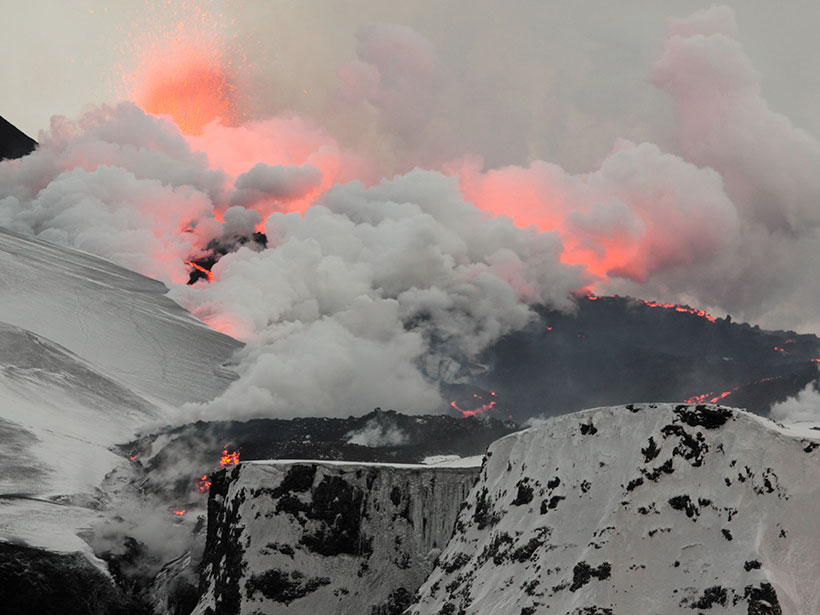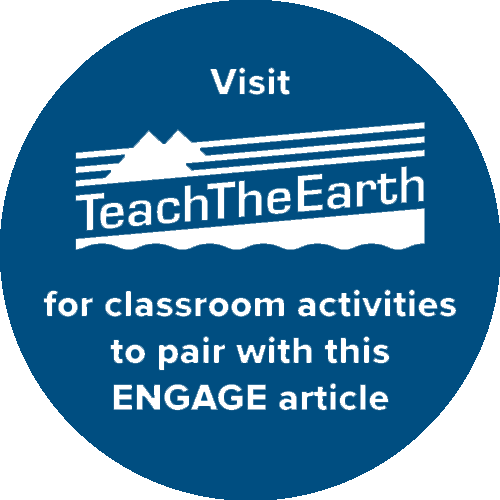Lara Mani was tired of hearing about the Yellowstone supervolcano. Every so often, another news story would appear, proclaiming that the Yellowstone caldera system could erupt with such ferocity that the impacts could cascade into a global catastrophe. “Yes, there’s plausibility in that,” said Mani, a research associate at the University of Cambridge’s Centre for the Study of Existential Risk, “but that’s not the only mechanism. There’s another way that can happen.”
Smaller eruptions, depending on where they occur, could also have catastrophic impacts, Mani thought. Historically, researchers have focused largely on the physical risk—the magnitude of potential eruptions. That’s at least in part because the vulnerability side—the transport routes, communication networks, and other infrastructure that if disrupted would affect societies around the globe—has become a problem only more recently.
“Most of the vulnerability is a relatively new (late 20th–21st century) product of how we humans have changed our technologies, economies, and flow of services,” said Chris Newhall of the Earth Observatory of Singapore. But we’ve already seen how small eruptions can lead to major disruptions. Consider the 2010 eruption of Eyjafjallajökull in Iceland, which grounded more than 100,000 flights and cost the global economy upward of $5 billion.
“That should never have reached the global platform that it did; it was such a small eruption,” Mani said. “Why? What’s the mechanism behind that? What does this mean? That’s where it started.” In a new study in Nature Communications, Mani and her colleagues began brainstorming identifying areas where smaller eruptions could combine with human-made vulnerabilities with catastrophic results. The new knowledge could lead to risk assessments and changes to preparedness.
Pinch Points
Mani and her colleagues began by looking at choke points along shipping routes—a focus that was highlighted this year when a container ship ran aground in the Suez Canal, bringing a major global trade route to a halt. They also looked at air traffic routes and other critical infrastructure like underwater cables and manufacturing hubs. The team identified seven “pinch points,” where active volcanoes overlapped with these vulnerabilities. Four of these points were clustered together in a highly populated geographic corridor from Southeast Asia through the South China Sea. “It makes sense that where you have people, you have systems to sustain those societies,” Mani said.

A small eruption at Mount Paektu on the China–North Korea border, for example, could disrupt air routes between Seoul and Osaka or Tokyo—some of the busiest routes in the world. In the Luzon Strait, a landslide or tsunami caused by an eruption along the Luzon Volcanic Arc could sever critical submarine cables connecting countries from China and Taiwan to the Philippines. Some 40% of global trade passes through the Strait of Malacca (between Malaysia and Indonesia); an eruption of any number of volcanoes along the Indonesian archipelago could shut down air and maritime traffic. The cascading impacts of these events are unpredictable and difficult to calculate: The 6-day blockage of the Suez Canal, for example, cost the Egyptian government as much as $90 million in lost toll revenue. Global trade revenue sank by as much as $10 billion.
“We’ve prioritized efficiency over resilience. If something goes wrong, there isn’t an alternative.”
“We’ve prioritized efficiency over resilience,” Mani said. “If something goes wrong, there isn’t an alternative.”
Taiwan is home to the Taiwan Semiconductor Manufacturing Company (TSMC), responsible for manufacturing 90% of the world’s advanced microchips and nodes. An eruption in the Tatun Volcano Group could close the port of Taipei, isolating TSMC from the rest of the world. “Anything that happens to TSMC…sends a shock wave [through society],” said Mani. “Everybody knows that it’s a critical vulnerability, but no one has ever thought about what it’s vulnerable to.”
The team also identified pinch points in the Mediterranean, the North Atlantic, and the Pacific Northwest, where the eruption of one of the Cascades volcanoes could melt glaciers or ice caps, triggering a debris flow that could potentially reach all the way to Seattle.
Mani hopes that pointing out these vulnerabilities in global systems will ultimately help to build resilience. “My hope is that it will raise some questions to the volcanology community, the volcanic risk community, to start having these discussions about what this risk really looks like,” she said, “so that disaster managers, international organizations, and governments can start thinking about mitigation and prevention.”
—Kate Wheeling (@KateWheeling), Science Writer
This news article is included in our ENGAGE resource for educators seeking science news for their classroom lessons. Browse all ENGAGE articles, and share with your fellow educators how you integrated the article into an activity in the comments section below.
Citation:
Wheeling, K. (2021), The understudied risks of low-magnitude eruptions, Eos, 102, https://doi.org/10.1029/2021EO163108. Published on 14 September 2021.
Text © 2021. The authors. CC BY-NC-ND 3.0
Except where otherwise noted, images are subject to copyright. Any reuse without express permission from the copyright owner is prohibited.


